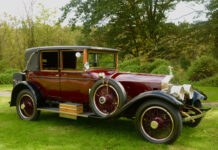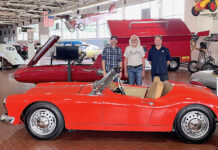By Jay Hirsch
SIATA stands for Societa Italiano Auto Transforzioni Accessori, which in English means Car Transformation Accessories Company. Founded in 1926 by Giorgio Ambrosini, Siata made performance parts to modify and tune cars. After WWII the company started to make its own sports cars under the SIATA name.
In 1953 Siata introduced the 208 as a roadster and a coupe. The CS signifies coupe. The coupe was also raced on the European circuit. The 208 was made from 1953 to 1955. Sold in the U.S., the price was somewhere between $8,000 and $10,000. This price limited sales to a handful in the U.S., as one could buy a Porsche, Jaguar or a Ferrari for less money.
In 1959, the ’54 208 CS seen here was relegated to a used car lot on Queens Boulevard in Queens, N.Y. Julius Eisenstark, a dentist by trade and car nut at heart, saw the Siata on the used car lot. Two weeks prior to this, Julius had test driven for two days, a 1956 Mercedes Gullwing from another used car dealer. He did not like driving the Gullwing. It was difficult getting in and out, and Julius was not thrilled with the car and the used-car price of $5,000-plus dollars.
The sight of the Siata excited Julius even though he did not know what he was looking at, and the price was a “reasonable” $1,900. Julius went home and asked his son Walter (the current owner who inherited his father’s DNA car gene) if he had ever heard of a “Siata”? Walter went to the bookshelf and took down a book on European cars. There in the book was a picture of a Siata. He showed it to his father, who exclaimed, “That is the car!” When Julius first laid eyes upon the Siata it was love at first sight. Julius went back to Queens the next day and bought the car. This was September 1959 and the beginning of life-long family affair.
The Siata had 19,000 miles on it, and those were “hard miles,” as it was driven on racetracks in New York, Connecticut and Pennsylvania. Sometime between 1954 and 1959 when the Siata was on the used car lot, one of the car’s previous owners had the car repainted in a dark red. It was originally blue, as seen here.
After owning the car a short time, Julius determined the car needed a mechanical rebuild of both the transmission and the “8 V-engine”—a two-liter Fiat V-8 which is called an “8 V.” Julius did the work himself.
“Working on an engine is a piece of cake compared to the restricted area of a mouth, and with no complaining by a person,” he said.
In 1966 the engine again needed some work
“Italians are great designers,” he said, “but ‘durable’ does not seem to be in the Italian language for automobile engines”—which did not bother Juliius, for “love is blind.”
In the early 1960s Julius made some refinements to the car, which it was totally lacking. A heating and ventilation system were installed, along with a defroster for the window and a larger radiator to prevent potential overheating. The interior was trimmed out to be more accommodating for Julius and his wife for the weekend drives they would take in the car.
Sometime in the 1970s the car was sanded down and resprayed, again in the same dark red. As the car hobby grew in the late 1970s, Julius would take the Siata to local car events and never got tired of answering, “Sea Otter—never heard of it who made it?” In the late 1980s that $1,900, used-car-lot special that a young teen Walter showed his father a picture of was now in Walter’s care.
When Fiat produced their first 8 V-engine they were more than happy to sell it to anyone who wanted it, so as to ensure the production of the engine would be profitable. Siata thought the size and power output would be a perfect match for its new 208 C and 208 CS. The 8 V-engine was a 70 degree OHV aluminum alloy 121.9 cid/two-liter V-8 with 8.5:1 compression putting out 125 HP with two 2-bbl. carburetors mated to a five-speed manual transmission. The Siata weighs 2,200 pounds, is 160 inches in length, with a height of 48 inches, and a top speed of 119 mph, riding on 6 x 16 tires.
In U.S. ads for the 1953 Siata, the copy said, “Chrysler V-8 and Cadillac V-8 engines also available on special order.” It is not known if any were ever ordered.
Due to the 1973 oil crisis, sales of sports cars in Italy tumbled. Siata ceased producing cars in 1975.
The mechanics of the car are what kept Julius and Walter’s ongoing interest in the car, aside from its beauty—the aluminum engine, the fully-independent suspension, the all-aluminum body and the sensation of driving the car. The car is a 1954, but the driving experience is years ahead of its time. The car likes to be driven and not slowly or timidly. An aggressive attitude in driving is appreciated by the car. The car is firm and responsive and, for its time, quick.
Walter has displayed the car at numerous car events. On that long list are the Greenwich Concours and the 2018 Concours at Amelia Island, Fla. Which brings us to how and why the car is now blue.
In September 2017 the car was at Automotive Restorations Inc. in Stratford, Conn., in preparation for the March 2018 Amelia Island Concours. The car was out on a test run to see how the engine performed and if there was any suspension work needed. While stopped for a traffic light another driver who was texting never looked up and plowed into the rear passenger side of the Siata, pushing the car into the car stopped in front of it. There were no skid marks. The driver never slowed down or applied the brakes. There were several eyewitnesses to account for this. The police confiscated the cell phone of the driver, and it was confirmed she was texting.
There was no question that the Siata was going to be rebuilt. The question was how long would it take and how would it look.
ARI (Automotive Restorations Inc.) is one of the premier automotive, repair, maintenance and restoration shops anywhere in the world. If there was a Top 5 list, ARI would be No. 1 or No. 2. ARI does all work in-house, from metal fabrication of fenders and chassis to original factory specs, to their own in-house interior and upholstery facility.
In the process of dismantling the Siata, on the interior of the rear window there could be seen the original blue paint the car first graced the world with. Walter decided the car should be brought back to its original glory. A wood buck was made in the form of the body and all new aluminum was hand shaped and formed for each body panel just as it was done when the car was made in 1954,
The engine and transmission were disassembled and rebuilt, and the interior was restored to “as original.” All of this was with the intent for the car to be at Amelia Island in March 2018. There were days when eight or nine people were working on all the various components of the car.
After five months of 60-hour-weeks the end result was a first-in -class award for Walter and his Siata and the entire crew at ARI the 2018 Amelia Island Concours. •



